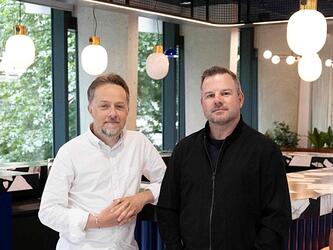Will all the best market research breakthroughs come from outside the industry?
If you’re interested in tech innovation, watch Silicon Valley. This HBO comedy has won critical acclaim for mocking the egos of the Californian tech scene. It’s also gradually introducing the language of tech development and investment to a wider audience: sprints, scrums, and the ‘three-comma-club’*.
One term already entering the wider business lexicon, is ‘pivot’. Awkward CFO Jared explains it excellently:
“A lot of successful start-ups launch with a different business model, and when they ran into trouble, they ‘pivoted’ to something new. Like Instagram was a location based check-in service when it started – and they pivoted. Or Chat Roulette… that was social media… and then they pivoted to become a playground for the sexually monstrous.”
In the show, the characters are forced to contemplate pivoting when they’re on the brink of failure. Less strategic innovation, more ‘we’re screwed, we need a new idea’.
However, pivoting can be far more positive. Last year, the research industry saw an excellent example. When Marie Wolfe of Unilever was looking to solve the challenge of inaccurate self-reporting from respondents, she found the answer she was looking for, not in research, but in a tech start-up in an entirely different industry. Alex Foster ran a company called Glass Fit – using Google Glass to provide a virtual running partner for fitness buffs looking for a boost.
However, Alex met Marie and Marie shared her research challenge. Alex pivoted, finding an entirely different purpose for its glass tech and coding skill-set. Within a week they’d created WeSeeThrough, an innovative MR firm – using Google Glass and proprietary video curation and editing software to deliver actionable insights… by looking through consumers’ eyes. They use Google Glass to see what consumers are seeing, push questions via glass software, and filter through the footage to find insights and opportunities Unilever hasn’t seen before.
This has brought Unilever breakthrough insights and netted WeSeeThrough the 2015 MRS Award for Innovation in Research Methodology. However, Alex Foster, by his own admission, had no research experience. And every researcher I’ve discussed this with has been both impressed by WeSeeThrough, and a little annoyed they didn’t create it.
We need more of this. More companies taking advantage of emerging technologies to genuinely innovate. More individuals looking outside of the skill-sets abundant in research. More agencies getting either impressed or scared, and speeding up their pace of innovation. The crux of WeSeeThrough was turned around in a week. Admittedly, pivoting meant they were building from a base of knowledge and IP, but the point still stands. It’s fast; Silicon Valley-esque fast.
This need for increased market research innovation is a key topic in the new report on online insight communities, Customer Inside, from C Space and the Market Research Society. The report, published this week, provides a client-side view on how to get the most out of online communities. It’s a positive and exciting picture. Investment and perception are strong. The 20+ client-side insight practitioners interviewed revealed an array of impactful uses for communities and some clever tactics for maximising their impact internally.
One insight professional described their customer community as a ‘Trojan Horse for insight’. For them, it was a platform that allowed them to keep hammering home their message of customer centricity to their organisation.
However, amid the positivity, the research, led by Charlotte Burgess and Robin Van der Aar of C Space, also revealed pitfalls and pain points. Some were simply avoidable mistakes. Mis-steps that veteran practitioners were able to share candid advice on (e.g. the necessity to start building a business case for the impact of your insight community right from the very start, and some specific ways to do so).
But, there were three bigger challenges, potentially ripe for technological innovation. From the 100 practitioners surveyed:
- 86% wanted more ‘integration with other sources of data’ (e.g. social media listening, customer data). This would allow them to provide more credible, intelligent synthesised outputs and recommendations.
- 65% wanted more ‘live, in the moment data & insight, rather than considered comments’. While not community related, WeeSeeThrough is a fine example of this.
- 44% wanted greater agility – ‘communities that are easier and faster to deploy to new markets’. While communities were perceived as very fast and cost effective for engaging audiences that you’re already interested in, they were paradoxically slow for speaking to a completely new, unexpected audience.
Some businesses were making progress. However, there was a sense of frustration that, amid all the success stories interviewees shared, the full potential of communities was still yet to be realised. There’s a danger of commoditisation slowing down change.
In the right hands, there is something rather unique about communities. In most cases, a group of customers have voluntarily agreed to enter into a conversation with a business, on-going, all-year, at scale. It’s hard to find a C-suite report that doesn’t shout about the need for greater customer-centricity. Talking to them, authentically, all year, online, is a great place to start.
It’s a forum fuelled by technology. But there are emerging technologies (like VR, video compression, IoT, speech to speech translation) that could further revolutionise qualitative research.
The part of WeSeeThrough’s story which lit a fire for me was that Alex Foster was not a researcher. He was an entrepreneur and developer, playing with an emerging tech in an entirely different field. He happened to turn his gaze to qualitative research. I’d really love the next breakthrough solution to getting closer to customers to come from within the research industry, not from outside. Let’s see what we can build.
Jonny Wooldridge is associate director, Consulting & EMEA vice-president, C Space
Reference:
* The ‘Three Comma Club’ refers to billionaires. “A million dollars isn’t cool. You know what’s cool? A billion dollars.”

We hope you enjoyed this article.
Research Live is published by MRS.
The Market Research Society (MRS) exists to promote and protect the research sector, showcasing how research delivers impact for businesses and government.
Members of MRS enjoy many benefits including tailoured policy guidance, discounts on training and conferences, and access to member-only content.
For example, there's an archive of winning case studies from over a decade of MRS Awards.
Find out more about the benefits of joining MRS here.













5 Comments
Annie Pettit, Chief Research Officer, Peanut Labs
9 years ago
Thinking purely about the title, "Will all the best market research breakthroughs come from outside the industry," the answer is simply no. All the best breakthroughs WILL come from within the industry. The problem is that traditional marketing researchers fail to recognize that anything other than surveys and focus groups is also part of the industry. As long as we keep our eyes on the page we're currently reading and never get to the next chapter, it's going to seem like 'other' industries are infringing on our work. Well, no, they're just continuing the work that we were to slow to progress into. We need to turn the pages a lot faster than we currently are.
Like Reply Report
Jonny Wooldridge, VP, C Space
9 years ago
Hi Annie! (or @LoveStats as i more commonly see you :) I agree with your nuance. and with the 'need to turn the pages a lot faster'. When I say from 'outside' the industry - my bigger fear is that there are big unrealised opportunities because not enough people are playing with purpose on the boundaries (the next chapters). OR don't have the skillsets to make them into scalable products. Other people have played with wearables for insight and immersion before WeSeeThrough. But the IP and coding ability to build their video curation platform into something scalable and sellable was out of a silicon valley startup. When i reference the gibson quote re the future being unevenly distributed - its extremely concentrated in tech hubs! My other fear is speed. We saw some not particularly breakthrough 'products' launched at agency prezzos at the recent MRS conference...that had apparently been in development for 'years'. Thats a bit disappointing to me. What are your thoughts?
Like Reply Report
Brent White, Founder, Peoplefocus
9 years ago
I doubt if ALL of the breakthroughs will come outside the industry, but suspect that many of these (as you provided in your example) will be happen when the edges of two disciplines/fields meet. Another example of this was was the move years ago to using the telephone as a means to collect data vs. person to person or mail surveys. If you haven't read the book, The Structure of Scientific Revolutions by Thomas Kuhn, you may want to pick up a copy (written years ago, 1962). As I recall, he presents some interesting examples of how scientific breakthroughs happen.
Like Reply Report
Annie Pettit, Chief Research Officer, Peanut Labs
9 years ago
Hi in return @jonnyw84 :) I find it interesting that when we talk about innovations in marketing research, the first thing that comes to mind for most of us is moving offline surveys to online. That's our best example. That was TWENTY years go. Are we saying that the last major innovation in our industry was 20 years ago? Obviously that's not true and many innovations have happened since then. However, for the most part, those innovations, as you suggest, are not breakthroughs but rather incremental interesting developments. I do agree that not enough MR skilled people are working with genuine innovations that require serious technical skills. Those innovations are in Chapter 17 and we're still on Chapter 3. It disappoints me that we can't move faster than that but boy we sure love clicking on the "Create Survey Launch Sample Show Final Report" button.
Like Reply Report
John Griffiths
9 years ago
Provocative post - I accept that innovation does come from outside - the much maligned focus group was borrowed as a tool from psychotherapy. Researchers at the time insisted that you had to be a trained psychotherapist to use it properly - that wasn't true. Focus groups could be used much more swiftly and intuitively than the theoreticians warned us. I would distinguish between methodologies and research implementation. Technology has allowed us to use digital tech to sit like jockeys on customers' shoulders - but getting up close and personal is only part of the story - there needs to be a researcher to see what matters and we need an interpretive framework to make sense of it. The tech innovators are trying to automate those as well. But research needs someone to frame it and to be able to assess what is signal and what is noise. Even if the tech does all of that - there needs to be an editor. The research innovation in your Google Glass example was the client looking outside. Not the techie with Google Glass and running shoes.
Like Reply Report